Menton cemetery with sea views
Historical and cultural site
45 min
chapel
Description
The ruins of Menton's old 13th century castle were purchased by the municipality in 1807. The castle previously belonged to the Prince of Monaco, but became state property after the French Revolution.
After long renovation work, which also included the grinding of the remaining castle walls, the cemetery did not find its present form until 1902. You can hardly see the structures of the old castle. The location is unique, in three directions you can see over the city to the sea. East to Italy, south down to Menton and west to the Cap Martin. In the north, the Alps arch upwards.
Most of the graves date from the first decades of the 20th century, but reading the inscriptions reveals burials that are more recent. Many graves remain unchanged because they were assigned for eternity (concession à perpétuité). So today you see more renovation work on monumental tombs than burials.
No reproduction is permitted without the written consent of the author. (id5308)
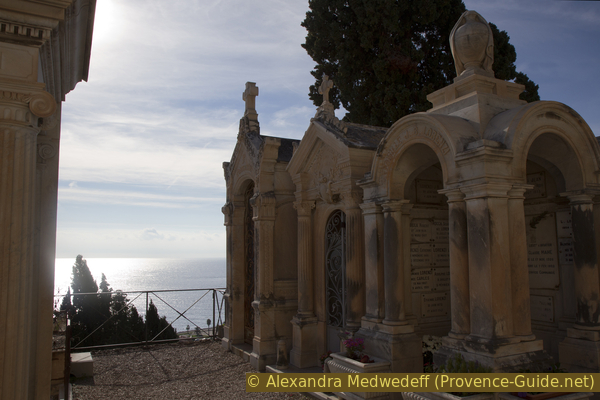
Burial chapels at the Cimetière du Château in Menton
The graves of locals are interspersed with those of mostly wealthy immigrants. Among them are mainly English, Russian, Poles and Germans: John Richard Green (English history scholar), Alfred Woltmann (German historian), William Webb Ellis (inventor of the sport of rugby), Hans Georg Tersling (Danish architect), Abel Glena and Alfred Marsang (Menton architects), John Moggridge (English botanist), Caroll of Carollton (co-founder of the American Hospital at Neuilly), Prince Troubetzkoy (adjutant to the Tsar) and others.
Entrance is free, this public cemetery is open every day from 8 a.m. until 8 p.m. It closes at 5 p.m. from the beginning of November to the end of March.
Just before our visit, a good-natured person placed roses on neglected graves on All Saints' Day.
No reproduction is permitted without the written consent of the author. (id5352)
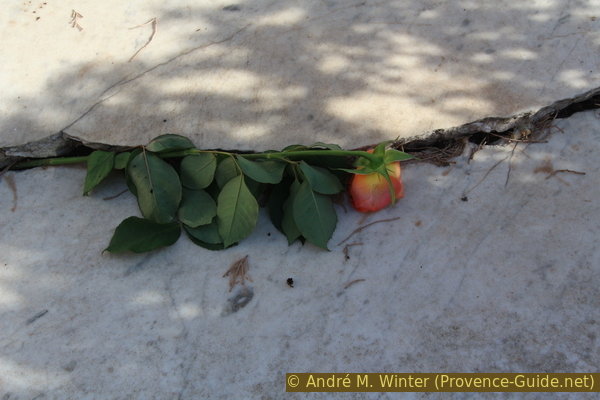
Rose on an old grave
Access by public transport
Most trains stop at Menton station. Among the regional lines, the one between Marseille and Ventimiglia is relevant, information can be found under TER PACA (only french). The train station is a bit far from the bus station, you have to leave the station building to the east (left) and left again to pass under the tracks.
All buses start at the bus station. Lines 8 and N4 go to the entrance of the cemetery, the stop there is called Le Trabuquet. Attention, there is also the station Cimetière du Trabuquet, this is the new cemetery and not the one described here. Information under Zest Transports Riviera (only french).
Also see the map on this page to locate the bus station and entrance to the cemetery.
You can also walk from the train station to the cemetery. It is best to first walk along the sea to the old town and then up through it. It takes about 40 minutes one way.
There are many roads and stairs leading up the hill, but the cemetery has only one entrance on the north. If you start from Fontana square near the port, you climb through the narrow streets and between the colorful houses. If we are arriving at a wall, we keep going up to the highest point where the entrance is.
Access by car
One cannot really recommend driving to Menton by car. Up to the cemetery is just as little recommended because you will hardly find a free parking space there. It is best to drive to the paid parking lot between the market hall and the port. Then you climb up to the cemetery on foot, following the suggested route on the map on this page.
No reproduction is permitted without the written consent of the author. (id5306)
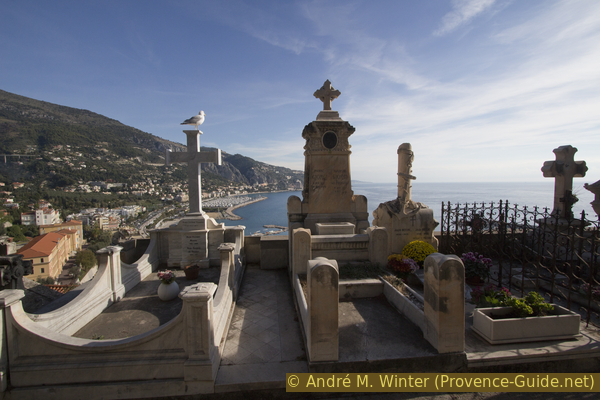
Tombs in the Cimetière du Château in front of the Baie de Garavan
The writer Gustave Flaubert passes through Menton and also visits this cemetery. He immortalized this on one page of his travelogue Voyage en Provence et en Italie et le retour par la Suisse between April and May 1845.
Menton. Italy begins, you can feel it in the air. Small streets with tall white houses, so narrow that hardly a vehicle can get through. Before you get there and also when you leave, the street is lined with oleanders, cacti and palm trees. beggar swarms. Children. Hike that I made along the sea on the big path. Olive trees and mountains to the left. Cemetery. Pale face of the gravedigger, thin man under a gray wool cap. What an admirable cemetery overlooking this ever-young sea! No cross, no grave! The grass is tall and green. The slight curves make the burial ground look like a mown field of wheat. What is actually growing there? Does the spirit ferment here to resurrect in another life surrounded by other scents while its old shell rots away? He showed us the men's side and the women's side, he named us the freshest graves, he lamented the trouble he's had for 30 years since he's been burying the local people. Serious by profession, without know-it-all, as a completely natural thing and still worth mentioning.
No reproduction is permitted without the written consent of the author. (id5310)

Orthodox burial chapel in Menton
Many of the tombs have far better views of the sea than most of Menton's houses.
No reproduction is permitted without the written consent of the author. (id5311)
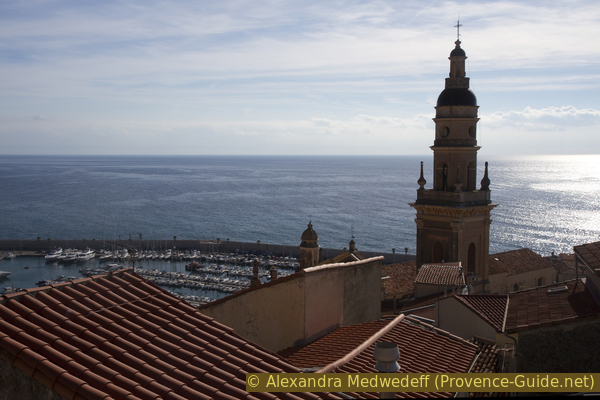
Quai Napoleon III and Saint Michel church tower
The old tombstones were often inscribed more descriptively:
To the memory of Alice Farquuharson, she died March 19, 1861 aged 12 years
In loving memory of William Whitworth Limbert, died January 30th 1889, aged 59
Ici repose Marie-Elisa-Camille Bounin, née à Philippeville (Algérie) le 4 juin 1847 et décédée à Menton le 3 september 1865, chérie de ces parents dont elle a emportée touts les regrets, elle sut aussi se faire aimer et distinguer de tous ceux qui l'ont connue par ses vertus et ses talents (Philippeville is the old name of the Algerian port city of Skikda).
Here rests Marie-Elisa-Camille Bounin, born in Philippeville (Algeria) on June 4, 1847 and died in Menton on September 3, 1865, beloved of parents whose regrets she took with her, she also knew how to make herself loved and distinguished from all those who knew her for her virtues and talents (Philippeville is the old name of the Algerian port city of Skikda).
No reproduction is permitted without the written consent of the author. (id5344)
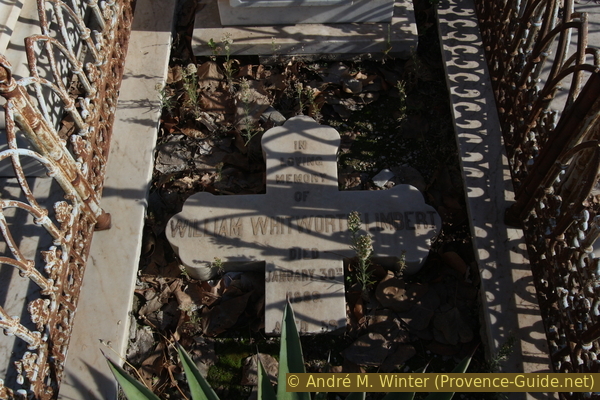
Grave with broken cross
No reproduction is permitted without the written consent of the author. (id5307)
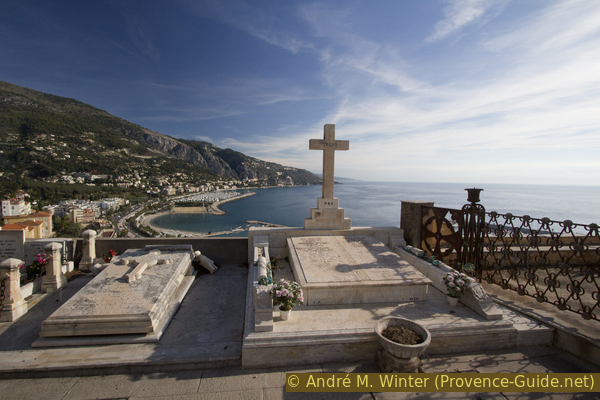
Cemetery Cimetière du Château above Baie de Garavan
No reproduction is permitted without the written consent of the author. (id5338)
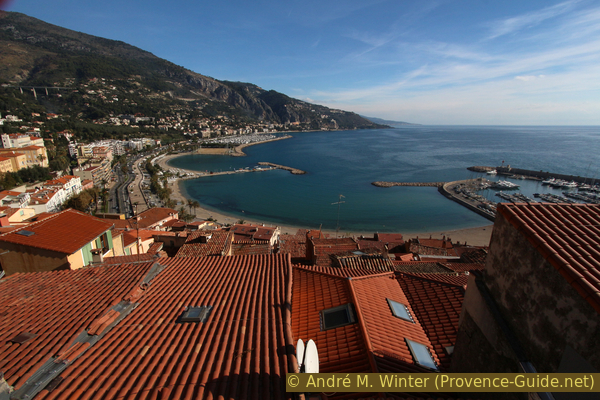
Port of Menton and Garavan
No reproduction is permitted without the written consent of the author. (id5309)
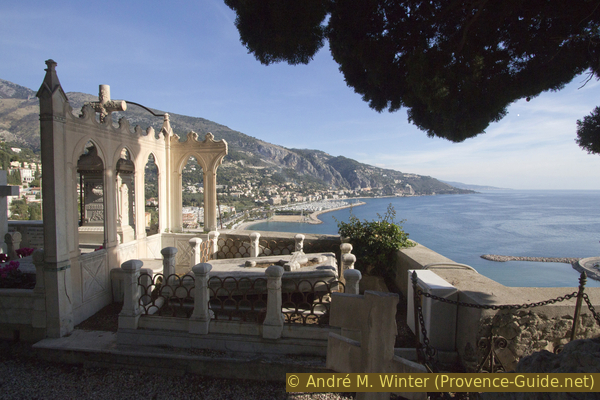
Large tomb with sea views